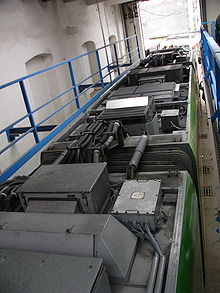This article's lead section may be too short to adequately summarize the key points. (December 2023) |


Regenerative braking is an energy recovery mechanism that slows down a moving vehicle or object by converting its kinetic energy or potential energy into a form that can be either used immediately or stored until needed.
Typically, regenerative brakes work by driving an electric motor in reverse to recapture energy that would otherwise be lost as heat during braking, effectively turning the traction motor into a generator. Feeding power backwards through the system like this allows the energy harvested from deceleration to resupply an energy storage solution such as a battery or a capacitor. Once stored, this power can then be later used to aid forward propulsion. Because of the electrified vehicle architecture required for such a braking system, automotive regenerative brakes are most commonly found on hybrid and electric vehicles.
This method contrasts with conventional braking systems, where excess kinetic energy is converted to unwanted and wasted heat due to friction in the brakes. Similarly, with rheostatic brakes, energy is recovered by using electric motors as generators but is immediately dissipated as heat in resistors.
In addition to improving the overall efficiency of the vehicle, regeneration can significantly extend the life of the braking system. This is because the traditional mechanical parts like discs, calipers, and pads – included for when regenerative braking alone is insufficient to safely stop the vehicle – will not wear out as quickly as they would in a vehicle relying solely on traditional brakes.
- ^ "Transforming the Tube" (PDF). Transport for London. July 2008. Archived from the original (PDF) on 5 June 2011. Retrieved 28 May 2009.